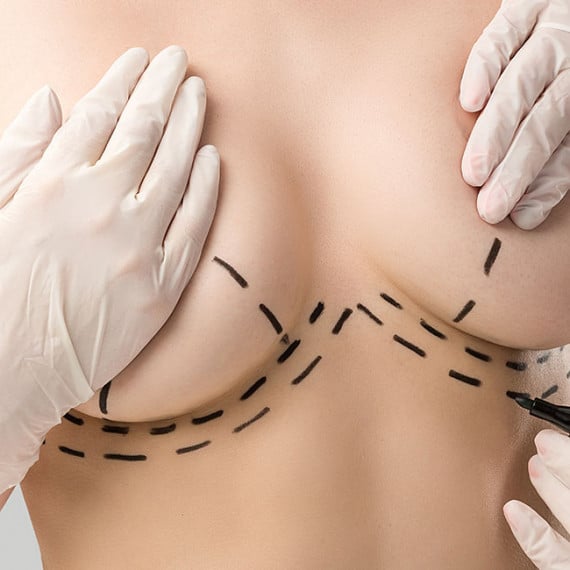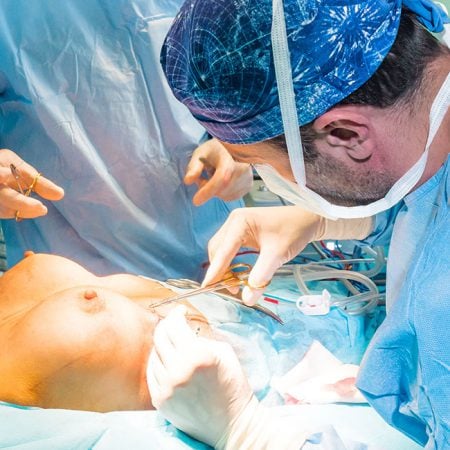Women with large, heavy breasts often experience physical discomfort in the back, neck, or shoulders. In addition, large breasts make some women feel insecure. They may avoid exercise and fitted clothing because of their breast size. Breast reduction surgery can help combat the problems often associated with large breasts.
Breast reduction surgery typically requires an anchor-shaped incision. Excess fat, skin, and tissue are removed, and the breast is sculpted into a smaller, more attractive shape. The exact technique may vary depending on your specific anatomy and goals. Breast reduction surgery can be a very rewarding and liberating procedure. Dr. Pasquale’s breast reduction patients report a very high level of satisfaction with their results. If you are interested in learning more about breast reduction surgery, please contact Dr. Pasquale.
There are many medical conditions associated with having large breasts. These include back and neck pain, skin irritation, skeletal deformities or breathing problems. Besides the discomfort that may come with having large breasts, they may be the cause of psychological self-image issues in both men and women.
Breast Reduction Costs
The cost for breast reduction at Infinity Life Center ranges from $6,000.00 – $12,000 depending on the size of the patients breasts, the patients current health and medical history and the type of breast reduction required to achieve the desired results. The length and difficulty of breast reduction surgery can be drastically different depending on the patient and method of breast reduction.
Our price ranges include the surgeons fees, the anesthesia and OR fees. Most plastic surgeons can only suggest or estimate a general cost for a given plastic surgery procedure as there are so many variables and unknown factors without seeing and evaluating a patient. Its always best to consult an experienced, board certified plastic surgeon who can evaluate you comprehensively in order to obtain an accurate price for a breast reduction.
Breast Reduction Surgery Scarring
Scars generally fade within a year of surgery, though they will be permanent. Depending on the type of breast reduction, they may range from small scars from the incisions made in liposuction breast reduction to bigger, anchor shaped scars that result after the traditional breast reduction procedure. These scars may appear red and lumpy in the first few months before healing is complete. However, the placement of these scars makes them easily concealed by a bra or a bathing suit. Healthy non smoking patients will heal faster than smokers, though either way the scarring after a breast reduction procedure will be permanent.
Breast Reduction Types & Incisions
Wise, Anchor Breast Reduction
The most common type of breast reduction surgery incisions is the anchor pattern incision. Named for the appearance of the scar that it produces, this incision method is advantageous for women with extremely large breasts. This method allows for the removal of the most breast tissue, maximizing the results of a breast reduction surgery, and allows for the removal of the most excess skin, which provides a smoother appearance.
An incision is made around the areola extending vertically down to the breast fold. The incision then continues horizontally along the breast crease in the shape of an anchor. This type of breast reduction is used to reduce moderate to extremely large breasts where a significant amount of breast tissue must be removed. This type of breast reduction results in the most scarring compared to the other methods but in the hands of an experienced plastic surgeon the scarring can be greatly minimized.
Vertical Pattern Breast Reduction
The vertical pattern breast incision technique is advantageous for women who do not require extensive tissue removal. This method results in less scarring, eliminating the horizontal scar along the crease of the breast. The vertical pattern breast reduction incision generally provides a more natural breast shape and requires less surgery time to perform. It is also referred to as the lollipop pattern incision, for the shape of the scar that it provides around the areola and vertically down the middle of the breast.
While the anchor pattern breast reduction incision can produce smooth results after only a month after surgery, it may take significantly longer for the result of the vertical pattern breast reduction surgery to smoothen and tighten.This pleated effect will smoothen out over time but this will happen gradually. Also, because this incision method does not allow for maximum access to the breast tissue, the nipple may have to be completely detached during this procedure, which will contribute to chances of a loss in nipple sensation and interference with breast feeding ability.
Lolipop, Keyhole, Inverted “T” Breast Reduction
The lolipop breast reduction begins with an incision around the areola which extends vertically down the front of the breast to the breast fold. No horizontal breast crease incision is required for this type of reduction method. This is the most popular and widely used breast reduction procedure employed as most patients dont require extensive breast tissue removal. This type of reduction results in less scarring than the anchor incision yet still allows for significant amounts of breast reshaping.
Liposuction Breast Reduction
This method is best used for patients who may have some medical aversions to anesthesia, whereas the liposuction can be performed under local anesthetic or sedation without extended anesthesia (putting the patient to sleep). This breast reduction type is best for patients with good skin elasticity and the least amount of ptosis.
Schedule a Consultation with Dr. Michael A. Pasquale
Consultations allow a plastic surgeon to evaluate you and answer all the important questions that are impossible to answer otherwise, such as surgery options and surgery prices etc, All consultations are complementary and by appointment only.
Breast Reduction Complications
All breast surgeries come with the possibility of complications. One of the more serious complications is the possibility of an adverse reaction to the anesthesia. Allergic reactions may result in symptoms such as nausea, vomiting, headaches, a sore throat, and shivering. Serious complications related to anesthesia can include the possibility of a heart attack or a stroke.
Another complication is the possibility that a hematoma may develop. A hematoma is a collection of blood in a body cavity, which usually occurs just below an incision. A hematoma may cause pain, infection, scar tissue. It may be apparent right after surgery or during the recovery period. A sudden change in the shape or color of the breasts can be a sign of a hematoma. The doctor must be notified immediately about changes like these.
Infection is another risk. Signs of an infection may be observed in around one to six weeks after surgery, and they include swelling, pain, redness, discharge, a foul smell, and fever. To avoid infection, the patient must take their prescribed medicines regularly.
Breast Reduction Risks
Breast reduction surgery carries the same risks as major surgery of any type such as: negative reactions to anesthesia, blood loss or infection. Beyond these general risks breast reduction complications may include: loss of sensation around the nipples or inability to breast feed, uneven or asymmetrical breasts requiring revisional surgery, excessive scarring, slow healing, tissue death or necrosis. The risks of infection normally increases as the amount of tissue removal increases.
Breast Reduction Recovery
The patient can expect swelling and bruising in the breast area after breast reduction surgery. Lotions or creams may be used to alleviate any itching or dryness. These should not be applied directly to the scars or incision sites, however. The patient will be wrapped in an elastic bandage which must be worn for the first two or three days following the surgery, although once this is removed the patient will still have to wear a surgical bra for the next few weeks. The stitches are removed in one to two weeks after surgery. Strenuous activity must be avoided during the healing process, although most women may return to work in about two weeks or less depending on the type of work that they do.
For the next few months, the patient should avoid unnecessary force or contact on the breasts. As well as breast sensitivity, the patient can experience an altered sensation in the nipples. Some patients experience a heightened sensitivity while others may feel a numbness. These changes are not permanent and will revert back to normal once the nerves begin to heal and shift.
Recovery of breast reduction surgery is a similar process to many outpatient cosmetic surgery procedures at our clinic. Its very important that you follow the instructions given to you by the surgeon and the clinical staff after your surgery is completed. Upon completion of breast reduction you will be awakened from anesthesia. Your incisions are dressed individually and your breasts are wrapped with bandages. All patients are kept under close observation by our registered nurses immediately proceeding their surgery in our recovery area. You will be given pain medication while your vital signs are closely monitored. The plastic surgeon will typically clear you to be discharged after 2 hours in recovery. Breast reduction patients are instructed to have someone pick them up and drive them home as well as help to take care of and monitor overnight until their first post operative visit the next day where the surgeon will give you a full check up to evaluate your recovery.






